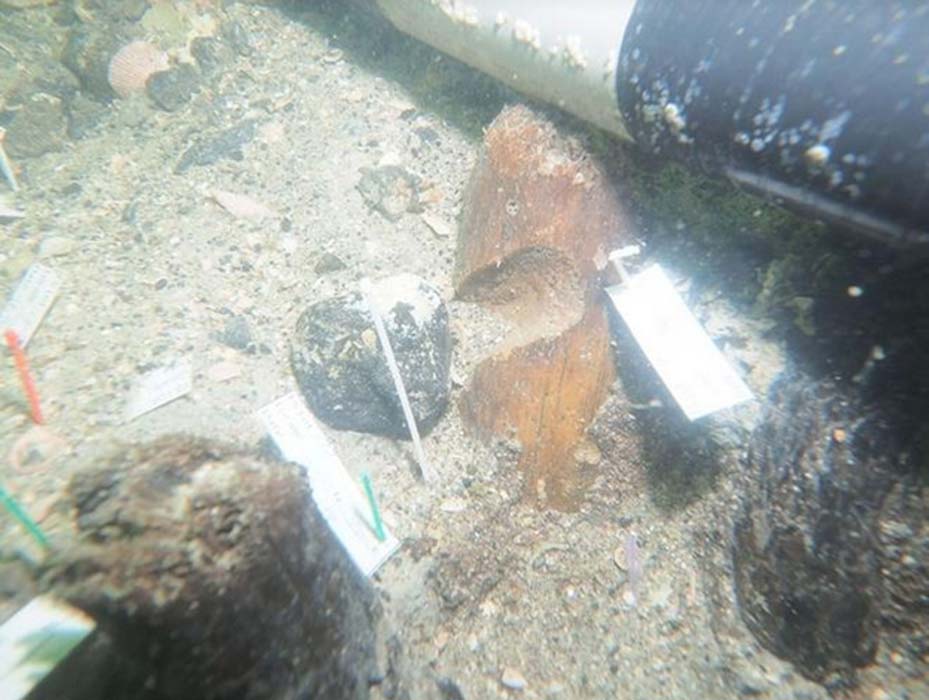7000-Year-Old Native American Burial Ground Discovered by Megalodon Tooth Hunter in Florida
Subaquatic Floridian archaeologists are no strangers to the vastly valuable off-shore treasures, but almost all of the historical discoveries made in the last century have been recovered from shipwrecks. Now, archaeologists in Venice have identified a 7,000-year-old prehistoric burial site submerged beneath the Gulf Coast waves.
This area of the Gulf Coast is a traditional hunting ground for divers searching for hand-sized Megalodon teeth, the enormous ancient shark that died out around two and a half million years ago. It was a Megalodon tooth diver who in 2016 “picked up a barnacle-crusted jaw from a shallow spot off the shore of Manasota Key,” according to an article in National Geographic.
A fortnight later the diver sent a picture of the jaw bone to Florida’s Bureau of Archaeological Research, where underwater archaeology supervisor Ryan Duggins inspected a "single molar.” The tooth was revealing in that it’s “cusps were worn smooth,” which Duggins said was likely caused by the person eating a diet of tough foods “a quick indicator we were dealing with a prehistoric individual,” Duggins explained to reporters at National Geographic.
Duggins and his team of pro underwater archaeologists revisited the dive spot where the jaw was recovered "about 300 yards from the shore and 21 feet below the surface.” Duggins first spotted a broken arm bone then a cluster of “carved wooden stakes and three separate skull fragments in a depression,” leading him to suspect that they had discovered a “miraculously preserved… Native American bog burial site."
- Hurricane Irma Uncovers a Rare Native American Canoe in Florida
- Lone Archaeologist Discovers First Multi-Year European Settlement in the U.S.
- Mystery of Kennewick Man Identity Finally Solved - DNA is Native American

Recording the contents of a depression in the sea bed. (Youtube Screenshot)
Around 13,000 years ago, the global climate began to warm and glaciers began to melt, sanding mountains into fields and inconceivable amounts of melt water caused a significant reduction in “habitable Florida.” The mass oceanic consumption of the prehistoric world of hunting and fishing caused modern marine archaeologists to hold little hope of finding such submerged Native American Indian sites, however, Duggins believes his discovery near Manasota Key proves “these underwater landscapes have much more archaeological potential.”
In 2017, Duggin’s team recovered “densely packed organic remains, including more human bones, sharpened wooden stakes and textile fragments” which radiocarbon dated to the Early Archaic period about 7,000 years ago, when the hunter gathers were transitioning from hunting to a new sedentary, agriculturally sustained, lifestyle. In the Archaeologist’s report, Duggins suggested the “whole graveyard could spread across an acre” and already researchers have counted at least “six individual sets of human remains, but there’s probably going to be a lot more,” Duggins added.

The find appears to be part of a large cemetery. (Youtube Screenshot)
Archaeologists know that these ancient cultures sometimes buried their dead in shallow, peat-bottomed ponds, made evident in a 1980s discovery on Florida’s east coast near Cape Canaveral at the Windover site. National Geographic reported that this ancient burial site contained an “8,000-year-old peat graveyard with more than 160 skeletons, some with their brains still preserved, as well as wooden stakes and textiles.”
Speaking of the ritual nature by which these bodies were buried, Duggins said “What we currently are thinking is that when an individual passed, they would have been wrapped in handwoven fibers and sunk to the bottom of the pond,” he explained. “A series of fire-hardened and sharpened stakes would be pounded into the pond bed around the body with the tops of those stakes protruding above the water line… at a time when the site was likely 10 feet above sea level and part of Florida’s mainland,” according to the National Geographic feature.
- The Windover Bog Bodies, Among the Greatest Archeological Discoveries Ever Unearthed in the United States
- The Calusa People: A Lost Tribe of Florida that Early Explorers Wrote Home About
- First humans in Florida lived alongside giant animals

An illustration depicting the burial of Windover bog bodies ( myfloridahistory.org)
This discovery will add significantly to archaeologists understanding of life in prehistoric Florida, which only 16 months ago grabbed the world’s headlines when a “a stone knife, mastodon bones and fossilized dung found in an underwater sinkhole show that humans lived in north Florida about 14,500 years ago,” about 1,500 years earlier than previously thought. According to an article in Popular Archeology "This is a big deal," said Florida State University Assistant Professor of Anthropology Jessi Halligan. "There were people here. So how did they live? This has opened up a whole new line of inquiry for us as scientists as we try to understand the settlement of the Americas.”
This latest discovery near Manasota Key adds another missing piece to the story of the development of rituals and cultural traditions in the Americas between 14,500 and 7000 years BC.
Top image: Carved stake found at Manasota Key Offshore archaeological site in the Gulf of Mexico, near Venice, USA. Source: Florida Department of State
By Ashley Cowie

















